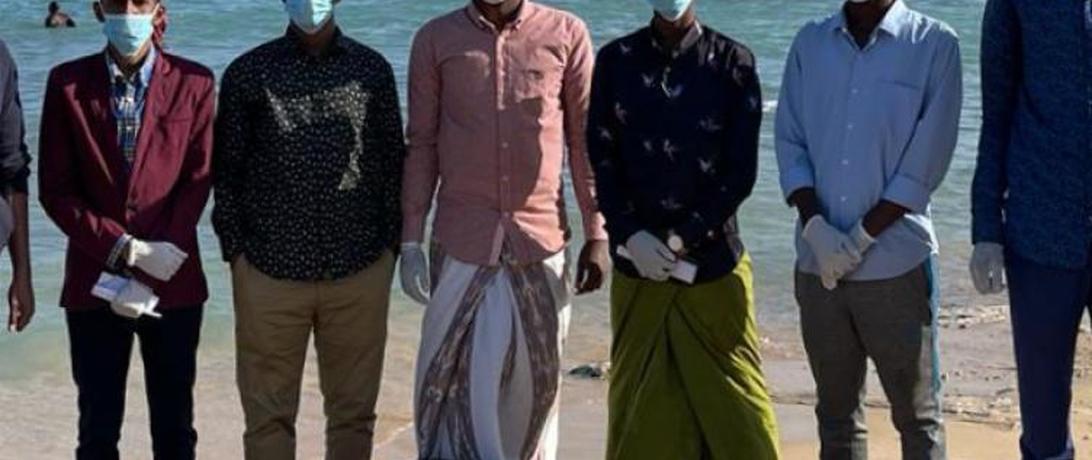
As we work to create a sustainable planet, we must equally prioritize sustainable peace. Our work in Somali fishing communities has shed light on ways science and natural resource conservation come together to reduce conflict and build community and environmental resilience.
As the world focuses its attention on the COP26 talks in Glasgow, it has never been more clear that global environmental health and human security are intertwined. A world at war cannot solve the environmental and climate crises. And a world facing unprecedented environmental struggles cannot be at peace. As we work to create a sustainable planet, we must equally prioritize sustainable peace.
Negative peace refers to the absence of violent conflict. But positive peace is built from healthy economic development and strong institutions, leading to changes in attitudes, improved social resilience, and greater structural equality. Peacebuilding that prioritizes positive peace prevents conflict before it begins, and that leads to sustainable peace. Similarly, resources that promote negative peace are usually tied to military funding, but resources that promote positive peace can amplify efforts that also build healthy ecosystems and mitigate climate change.
Our work in Somali fishing communities has shed light on ways science and natural resource conservation come together to reduce conflict and build community and environmental resilience.
-
Inclusive conservation prioritizes community needs while building scientific knowledge of resource users. Inclusive science goes far beyond diversity in representation: scientific inquiry should involve communities in creating hypotheses and in disseminating results. To the first point, scientists usually begin exploration with a set of questions or hypotheses. When these hypotheses come from a specific ecosystem or location, as questions of ecology and conservation usually do, they are implicitly about a human community that lives within, utilizes, and has a deep experiential understanding of the area. Scientists can and should ask that community to suggest hypotheses. The answers to such questions are much more likely to contribute to meaningful and immediately actionable scientific discoveries. And those questions are also more likely to promote community well-being around natural resources in ways that lead to equitable resource use.
-
Scientific diplomacy can build bridges between nations and people outside the usual boundaries of geopolitics. Science is not apolitical. Data is not apolitical. But sometimes groups within and between nations can come together over scientific issues even while larger political conflicts are brewing. When nations agree on joint resource management plans, for example, it builds bridges. When scientists from different countries work on environmental issues that span international borders, they become emissaries for their people. For example, a multinational group of scientists is working to monitor and conserve billfishes (such as swordfish and marlins) in the Western Indian Ocean. Scientists and students from six countries are sharing methods, data, and the lessons of their work. For the first time, scientists and students from Somalia have been included in a project funded by the Western Indian Ocean Marine Science Association. That recognition and partnership elevates future policy makers while cementing professional bonds that can help work through strife.
-
Citizen science engages locals in knowledge creation while building foundations for conflict-sensitive, intentional interventions. Successful conflict interventions must be grounded in reality and consider unintended consequences. The “Do No Harm” framework provides mechanisms for thinking through the downstream impacts of interventions (for both conflict or conservation), and providing opportunities for community members to directly contribute to data collection bolsters such efforts. For example, our team has engaged community members to collect fisheries data from locally based fishing boats. They work on the water, with fishers, to gather data that they then share with fisheries officials. One of the major conflicts in Somali waters is between local and foreign fishing vessels, and the fisheries data collected by the community informs government-led policy approaches to addressing this conflict. One critical point must be emphasized: pay your citizen scientists!
-
Conservation interventions that build trust also build peace. Trust is one foundation of conflict prevention and mitigation. Whether within a community, between a community and the government, or between communities and external actors like NGOs, social capital creates social contracts and respect. Scientists engaged in practical conservation and natural resource management know success comes from starting with community needs, actively involving communities in goal setting and monitoring and evaluation activities, and communicating results in a way that is actionable and accessible. Prioritizing community engagement spills over into greater community involvement and ownership over natural resource management, strategies that have been shown to improve peace processes.
Scientists must also actively decolonize their work and avoid helicopter science that may lead to recognition and publications, while doing little for (or worse, negatively impacting) the communities in which they work and study. I am hopeful that new approaches to inclusive science and community engagement will not only provide the data we need to create a healthy planet, but will also prioritize methods that build capacity and tools for more peaceful societies.
Article Details
Published
Topic
Program
Content Type
Opinion & Insights